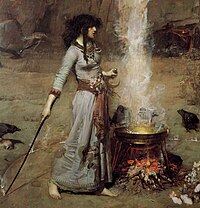
| Part of a series on |
| Witchcraft |
|---|
 |
Cunning folk, also known as folk healers or wise folk, were practitioners of folk medicine, helpful folk magic and divination in Europe from the Middle Ages until the 20th century. Their practices were known as the cunning craft. Their services also included thwarting witchcraft. Although some cunning folk were denounced as witches themselves, they made up a minority of those accused,[1] and the common people generally made a distinction between the two. The name 'cunning folk' originally referred to folk-healers and magic-workers in Britain, but the name is now applied as an umbrella term for similar people in other parts of Europe.[2][3]
Names given to folk-healers and magic-workers in Europe include:
- the Danish kloge folk ("wise folk")[2]
- the Dutch toverdokters ("magic-doctors") or duivelbanners ("devil-banners")
- the Finnish and Karelian tietäjät ("knowers")
- the French devins-guérisseurs ("soothsayer-healers") and leveurs de sorts ("curse-lifters")
- the German Hexenmeister or Kräuterhexen ("herb witches")
- the Irish bean feasa ("woman of knowledge"), banfháidh or fáidhbhean ("seeress")[4]
- the Italian fattucchiere ("fixers"), guaritori ("healers") or benandanti ("good walkers")
- the Portuguese curandeiros/as, benzedeiros/as ("blessers") or mulheres de virtude ("women of virtue")
- the Slavic vedmaki ("warlocks")
- the Spanish curanderos ("healers")
- the Swedish klok gumma ("wise old woman") or klok gubbe ("wise old man")[5][6][7][8][9]
- the Welsh dynion hysbys (from Welsh, meaning "cunning men")
- ^ Hutton, Ronald (2017). The Witch: A History of Fear, from Ancient Times to the Present. Yale University Press. pp. 24–25.
- ^ a b Davies 2003. p. 163.
- ^ De Blécourt 1994.
- ^ "2) Aoibheall". Theses.univ-lyon2.fr. Retrieved 2022-09-15.
- ^ "Swedish to English vocabulary list from Freedict".
- ^ Signum svenska kulturhistoria, Stormaktstiden
- ^ Jan-Inge Wall, Hon var engång tagen under jorden
- ^ Wicked arts: witchcraft and magic trials in southern Sweden, 1635–1754 By Per Sörlina
- ^ Witchcraft and magic in Europe: the 20th centuryby Marijke Gijswijt-Hofstra, Willem de Blécourt, Brian Levack, Ronald Hutton, Jean Sybil La Fontaine and Roy Porter, Continuum International Publishing Group, 1999, ISBN 978-0-485-89106-5[page needed]
© MMXXIII Rich X Search. We shall prevail. All rights reserved. Rich X Search
